[Foreigners Who Loved Korea] Mary F.B. Scranton: Fostering education for women
By Korea HeraldPublished : Nov. 1, 2016 - 17:23
Mary F.B. Scranton was born to a Methodist Episcopal minister’s family in Massachusetts in 1832. She married William Talcott Scranton in 1853, only to lose him at the age of 40. In 1885, she was dispatched as the first female missionary to Korea by the US Methodist Woman’s Foreign Missionary Society, and dedicated her life toward raising the status of Korean women.
Establishing values through missionary work
Protestant missionary work emphasized education, medical care and welfare. Early Methodist missionaries devoted their energy into modern education and disseminating medical care. The establishment of the church was directly linked to and carried out alongside educational missionary work, which was more than simply conveying knowledge or fostering abilities.
Establishing values through missionary work
Protestant missionary work emphasized education, medical care and welfare. Early Methodist missionaries devoted their energy into modern education and disseminating medical care. The establishment of the church was directly linked to and carried out alongside educational missionary work, which was more than simply conveying knowledge or fostering abilities.
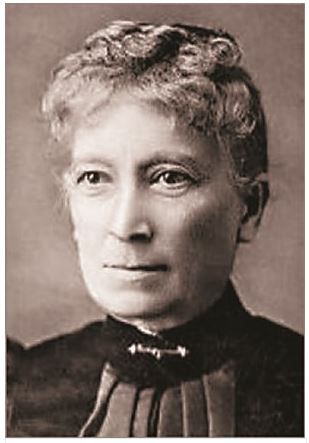
Henry G. Appenzeller, who founded the Baejae Academy, did not stop at teaching English and training interpreters. True to the meaning of the school’s namesake -- “Baejae” means “fostering talent” in Korean -- he strove to raise talented individuals who would sacrifice themselves for the people and the country. In addition, his ultimate goal was to raise Christians who loved peace and freedom.
Scranton, the founder of Ewha Academy, was also of the same mind and it was her goal to make Korean women into better people and have Korea develop into a great country in the name of Christ.
Bengel M.J., the wife of G.H. Jones -- a US missionary and founder of Incheon’s Yonghwa Elementary School -- also threw herself into education with the same goal. Their intention was to foster capable people proud to volunteer for society’s development, with a strong sense of urgency based on Christianity.
Awakening the self-esteem of Korean women
Having always dreamed of being a foreign missionary, she finally set foot in Korea with her only child, William B. Scranton, in May 1885, when she heard that Korea was receiving medical and educational missionaries.
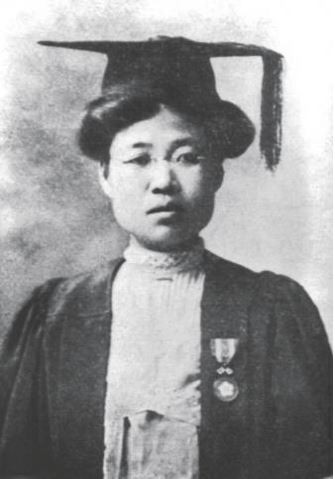
She was the first female missionary on Korean soil. Korea was in chaos at the time because of the 1884 coup. It was here that Mary exerted her efforts in female equality and education, while her son provided medical services and established a church. Mother and son devotedly carried out missionary work in this fashion.
After Mary found a place to live in Jeong-dong, Seoul, she began her efforts in women’s education, which led eventually to the founding and operation of Ewha Academy. However, she initially faced challenges, as there was a strong tradition of patriarchal values at the time. With the exception of a small minority, education then -- even for the elite -- consisted only of learning Hangeul, the Korean writing system. There was also a xenophobic attitude toward Westerners that made it difficult to attract students to attend the school.
On May 31, 1886, an individual surnamed Kim, a concubine of a civil servant, personally visited the school as she wanted to learn English to become an interpreter. This was the academy’s first one-on-one English class with just one female student, marking the founding of Ewha Academy.
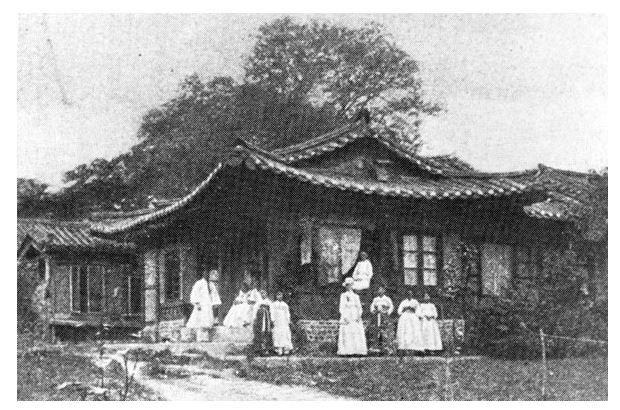
One month later, a destitute girl named Cho Byeol-dan arrived at the academy. Her father became both the school’s janitor and security guard, while her mother cooked in the kitchen.
The number of students at the academy increased to seven in 1887, with the addition of bible studies and Hangeul as subjects. The school was gradually building itself up as an educational institute for women. In November that year, a 200 pyeong school building with a tiled roof was completed. (A pyeong is a Korean unit of measurement, and 200 pyeong is equal to 660 square meters.)
Empress Myeongsong bestowed the name of Ewha onto the school, along with the well wishes: “May (the school) bear fragrant fruit as pure and beautiful as the pear blossom.”
It was meant as high praise for Scranton’s spirit in founding the school and as a wish for it to grow.
The school was so named because Jeong-dong had a building called Ewha Pavilion in a field of pear trees.
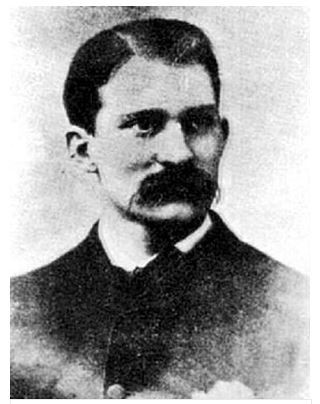
In January 1888, Korea’s first Sunday school was established on the campus, which eventually became a source of Korea’s female missionaries.
Many young missionaries in their 30s came to regard Scranton as their “godmother.”
Birthplace of modern female education
In 1889, Ewha Academy began teaching Hangeul and Chinese after hiring Yi Kyeong-suk as an instructor. The school taught Hangeul and English as basic subjects, along with other courses related to the Bible and religion.
As the number of students steadily grew, a tiled-roof dormitory was demolished and replaced with a two-story red brick building. In 1904, the school established a four-year high school track, producing its first secondary school graduate in 1908. It also established normal education and higher education tracks. In 1910, it established an undergraduate education track encompassing elementary, middle, and higher education.
The nationalistic consciousness of the students was also unique as the school was less repressed by the Japanese government than other schools. The students actively participated in student demonstrations from late 1929 to early 1930, during the March 1 Movement, June 10 Manse Movement, and the Gwangju Student Movement.
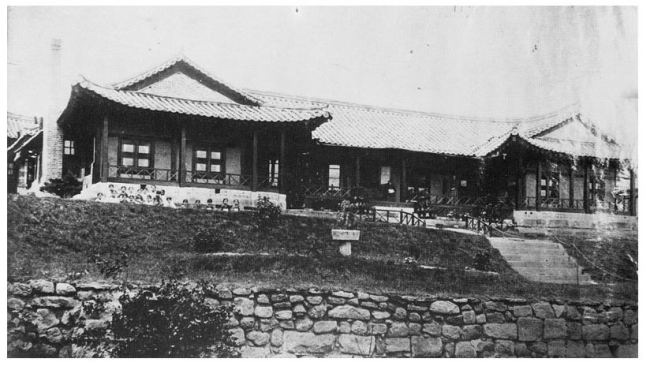
Before the school’s existence, female education was virtually nonexistent in Korea. The academy helped Korean women to realize women’s status through modern education, based on Christianity, which made it possible for them to participate in society.
Apart from Yu Gwan-sun, an emblematic female activist of the March 1st Movement, the school also produced historical figures such as Korea’s first Western-style physician Esther Park (whose real name was Kim Jeong-dong), and Ha Ran-sa, who launched a female enlightenment movement and participated in the independence movement after becoming the first female Korean to receive a Bachelor of Arts degree from the US. She later died as a patriotic martyr in Beijing.
The Simpson Memorial Hall (Registered Cultural Asset No. 3) on Ewha Girl’s High School’s present-day campus still has the site of the well where Yu Gwan-sun did her laundry and Sajumun, the original school gate.
In the yard of the campus’ main building stands a slab that memorializes this place as a historically significant source of education for women in Korea.
Serving the disadvantaged
“I have made up my mind to love the people of this country whether or not they like the work I am doing,” said Scranton.
True to her words, Scranton came to the then poor country of Korea in the spirit of Christ, and loved and sincerely served the Korean people. She contributed to revolutionizing the then dormant role of women in society, liberating them from the fetters of illiteracy, and helping to change perception toward them.
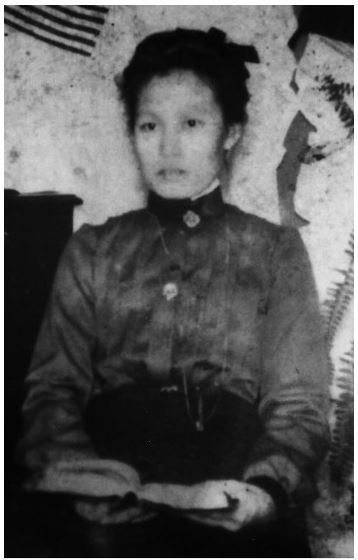
The school, which opened up a new space for women’s education, was also a lighthouse for the Korean women’s movement. This was one of the many reasons why Scranton’s educational activities were noteworthy.
Scranton also opened and ran Korea’s first women’s hospital, Boguyeogwan -- the predecessor to Ewha University Hospital -- while also widely disseminated the importance of hygiene in daily life.
In addition, she organized a female missionary church, engaging in evangelizing and educational work in the provinces, improving the rights of women, and making great contributions to education, medical care, and welfare.
Scranton also founded Sangdong Church and Women’s Bible School near Namdaemun, and focused on fostering female ministers. She spent her final years evangelizing around Suwon and Siheung in Gyeonggi Province and Gongju, South Chungcheong Province, and other places.
Koreans so respected her that they called her “Great Madame.” Scranton was considered a godmother by both Methodist female missionaries and Protestant female missionaries in Korea.
Scranton, who spent the last years of her life in Korea, died on Jan. 8, 1909 at the age of 77 after 25 years of spreading the Gospel. She was laid to rest in Yanghwajin.
Scranton was driven by love and passion to improve the status of Korean women. Her love, dedication, sacrifice, service and spirit of sharing were a beam of light during a dark period of Korean history.
By Kim Hyong-mo
Senior researcher, The Independence Hall of Korea
In Korea’s turbulent path toward independence and nation building, there were foreign nationals who stood steadfastly by the Korean people, although their contributions have been largely overshadowed by those of Korean patriots. The Korea Herald, in partnership with the Independence Hall of Korea, is publishing a series of articles shedding light on these foreigners, their life and legacies here. This is the 20th installment. -- Ed
-
Articles by Korea Herald



![[Exclusive] Korean military set to ban iPhones over 'security' concerns](http://res.heraldm.com/phpwas/restmb_idxmake.php?idx=644&simg=/content/image/2024/04/23/20240423050599_0.jpg&u=20240423183955)

![[Graphic News] 77% of young Koreans still financially dependent](http://res.heraldm.com/phpwas/restmb_idxmake.php?idx=644&simg=/content/image/2024/04/22/20240422050762_0.gif&u=)



![[Pressure points] Leggings in public: Fashion statement or social faux pas?](http://res.heraldm.com/phpwas/restmb_idxmake.php?idx=644&simg=/content/image/2024/04/23/20240423050669_0.jpg&u=)










